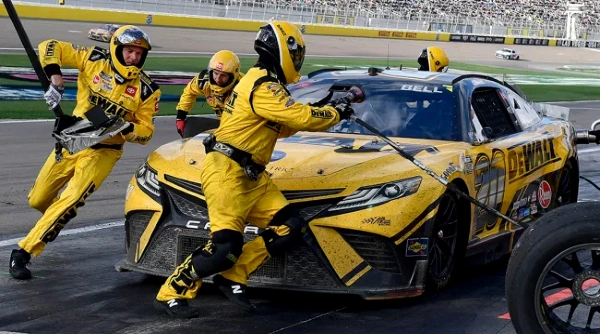In NASCAR, winning or losing can come down to just a few seconds, and nowhere is that more evident than in the pit stop. Every pit stop is a perfectly choreographed, high-stakes dance, where six crew members have 10-12 seconds to change four tires, refuel the car, and make any critical adjustments. The margin for error is razor-thin, and the pressure is relentless.
The speed and precision aren’t random. Teams spend hours analyzing tire wear, fuel consumption, and track conditions to determine the optimal time for a stop. They’re constantly weighing risk versus reward—pitting too early or too late can make or break a race.
Each crew member has a specialized job: tire changers, tire carriers, jackmen, and the fueler. Their coordination is military-grade. For the jackman, it’s about leverage and strength, getting the car up and down in a split second. For the tire changers, it’s about reflexes and precision—hitting the lug nut (or nuts in Xfinity) with surgical accuracy. And for the fueler, it’s about efficiency—delivering as much fuel as possible in the least amount of time.
But it’s not just about speed. Strategy plays a critical role. Crew chiefs make split-second calls, often using real-time data and telemetry to decide whether a two-tire change is enough or if they need to risk a longer stop for four new tires. They’ve got one eye on the stopwatch and the other on the race track, constantly assessing how the competition is moving and reacting to every variable.
Pit stops can also be dangerous. High speeds and heavy equipment mean that even a small mistake can lead to injury or cost valuable time. One slip can mean the difference between taking the checkered flag and watching it from the garage. Crewmen are often hit on pit road when a maneuver from the crew or the driver goes awry, and most often times they just keep working on the car regardless of injury. And let’s not forget the ever-apparent threat of fire. We occasionally see fire in the pit stalls, whether its coming from brake rotors during a tire change or a strange mishap during fueling, such as we saw at the Daytona Zero Sugar 400 when Hamlin’s exhaust briefly hovered fuel spill behind the car of Daniel Suarez. In the blink of an eye, the gas trail was aflame and transferred directly into the truck of the #99 car. The pit crew must be unafraid of all these things as well as prepared to handle them.
In a sport where every millisecond counts, the pit crew is the lifeline of the race. It’s high-pressure, it’s intense, and it’s one of the most thrilling elements of NASCAR. They’re not just changing tires—they’re changing the outcome of the race.

